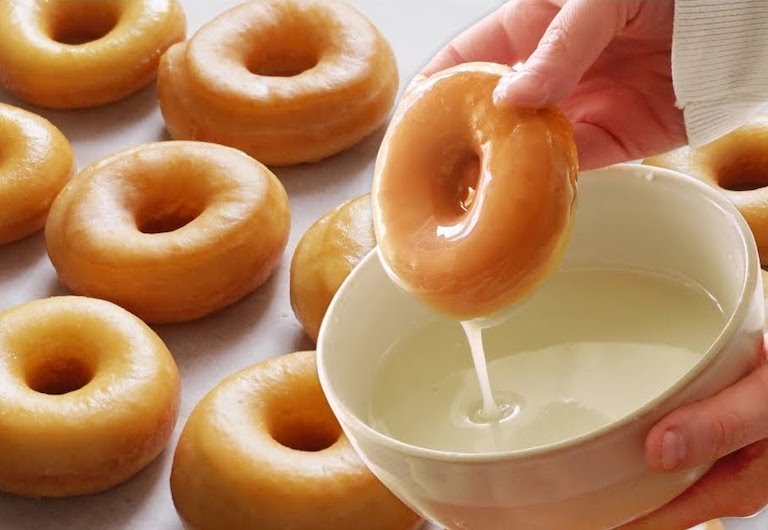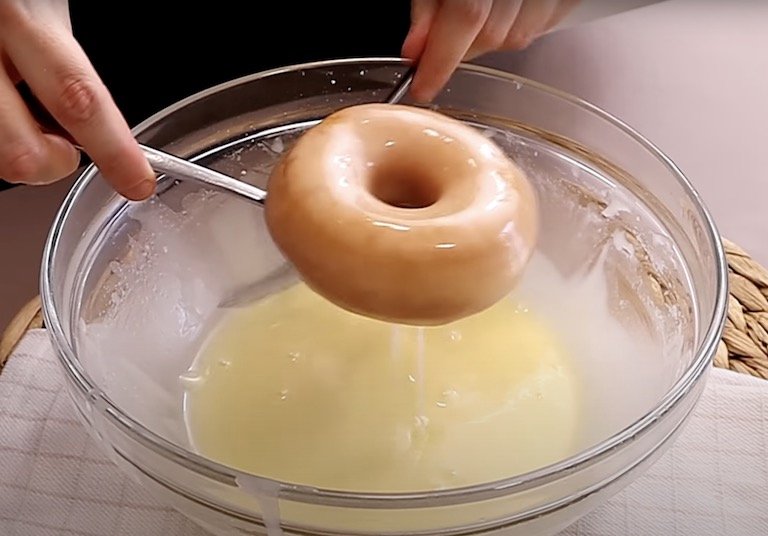Emma Fontanella’s no-knead, overnight yeast-raised glazed donuts—even better than Krispy Kreme!
About my No-Knead, Yeast-Raised, Glazed Donuts
These no-knead glazed donuts literally melt in your mouth, and come together without the hassle of kneading dough. With this recipe, you don’t need a stand mixer or any special equipment to enjoy amazing, warm, fresh, yeast-raised donuts!
I designed this method so you can quickly whip up a batch of dough the night before and just pop it in the fridge. The next morning, the dough will be ready so you can enjoy some fresh, warm donuts!
One of Emma’s finished glazed donuts. You can think of these as a homemade version of a classic Krispy Kreme.
If you’re looking to learn how to make real donuts at home, this is a great place to start. A mixing bowl and a spoon is all you need to prepare the dough.
They have a light, fluffy, texture and a golden crust. The classic donut sugar glaze has the perfect level of sweetness. Enjoy these as soon as they’re made, while they’re still warm—delicious! I think they’re even better than Krispy Kreme donuts, mainly because you can have these super fresh.
This recipe and the no-knead technique can be found in my new cookbook, Simple Pleasures. In the book you’ll find even more delicious donut recipes, such as authentic Italian donuts, custard-filled donuts, instant donuts, donut holes and more!
What kind of flour is best for making donuts?
For yeast-raised donuts (like the ones in this recipe), you want a a flour with high protein content (12% or higher), such as a bread flour. That’s because we want to develop a strong gluten network in the dough, which needs a high protein flour.
For cake donuts, though, a low protein all-purpose flour (less than 11% or lower), or even a cake flour, will give you the best results. For cake type donuts, a high protein flour will tend to make the donuts a bit tough.
What kind of oil should I use for frying the donuts?
At home, the best oils for frying donuts are oils with no flavor or aroma. Vegetable oil, peanut oil, and canola oil are all good choices. After frying donuts, once the oil as cooled, make sure to filter it to remove any solids,and store it in a sealed container for future re-use.
You can re-use the same oil for frying four times or more, unless you burnt something or tainted the oil with a strongly flavored ingredient.
Commercially, Krispy Kreme uses vegetable shortening for frying their donuts. That’s a mixture of palm oil, soybean oil, cottonseed oil and canola oil. Additionally, commercial fry oils often have additives designed to make the oil last longer.
The most popular donut flavors in the United States
There are many different styles of donuts that are popular in the United States, with lots of regional variation across states. In the illustrations below, I’ve included ten of the most popular styles—some old, some newer.
Part 1 of Emma Fontanella’s list of popular kinds of donut in the United States
Part 2 of Emma Fontanella’s list of popular kinds of donut in the United States
What’s the history of the iconic ring donut?
Of all the kinds of donuts we have, when we think of donuts today, one kind usually springs to mind—the classic ring shape with a hole in the middle. These are actually are an American invention dating back to the mid 1800s. Before that, donuts never had holes in the middle.
One popular origin story goes that the reason for punching out a hole in the middle the donut was to make the donuts less greasy than the older “solid” versions. Personally, I’m not really sure how that makes sense!
However, whatever the true inspiration for their invention, it took decades for them to become popular. Ring donuts didn’t really start to catch on until 1920, when an enterprising immigrant from Russia named Adolph Levitt invented the first ring donut-making machine.
By the 1930s, hungry crowds could be fed from what were then futuristic-looking automated donut making machines. This example is from 1933, in the store-front window of Mayflower Donuts in New York. Photo by Martin Munkacsi.
That allowed donuts to be made fast enough that hungry crowds of people could be fed quickly. By the mid 1930s, the automated methods of donut production meant that people saw donuts as modern and even futuristic food.
The first Krispy Kreme retail outlet opened in 1937 in North Carolina, with their slogan “Eat Krispy Kreme Doughnuts”
It was in 1937 that Krispy Kreme was founded, and in 1950, Dunkin’ Donuts entered the market. By the 1990s, Krispy Kreme was firmly embedded in popular culture, featuring in the super-influential TV show, Sex and the City.
Over the decades, donut-making machines became more and more refined and efficient. Today, from start to finish the entire classic glazed ring donut-making process takes under an hour—33 minutes of dough preparation and frying, and 25 minutes of glazing and cooling.
The scale is incredible. The busiest Krispy Kreme store sells 4,000 boxes of a dozen donuts every day. That’s 48,000 donuts a day from one store!
While for many Americans, the origin glazed Krispy Kreme donut remains the best, it isn’t the most popular. Today, Dunkin’ Donuts is a much bigger operation. Both chains have expanded their operations outside the United States, taking ring donuts around the world.
Today, Krispy Kreme has around 1400 stores globally. Dunkin’ Donuts, though, has over 13,000 stores—nearly tens times as many.
What is a yeast-raised donut?
Instant dried yeast. This is the typical kind of yeast added to the dough when making yeast-raised donuts.
Yeast-raised donuts are what most people think of as “regular donuts”. They’re made with yeast added to the dough as a raising agent, similar to the way you make bread.
The live yeast feeds on the flour in the dough, and in the process it creates carbon dioxide which makes the dough rise. So, the rise comes from the yeast, hence the term “yeast-raised”.
Is it better to use yeast or baking powder for donuts?
The answer to this question depends on what kind of donuts you prefer. Yeast donuts are most people’s idea of a classic donut.
The use of yeast in these donuts along with the method of working the dough gives the donuts their light, fluffy melt-in-your-mouth texture. If these are the kind of donuts you prefer, then using yeast is the way to go.
Baking powder is used in cake donuts which, as the name suggests, have a slightly denser “cake-like” texture. The use of baking powder means there’s no waiting for the dough to rise when making these kind of donuts.
Whereas with yeast donuts, you have to wait for the dough to rise. If cake donuts are what you prefer, then using baking powder is the better option.
Are Krispy Kreme donuts yeast or cake?
Most of the donuts Krispy Kreme sells are yeast donuts, including their classic glazed donut. They do, however, sell a few cake donuts e.g., the “Glazed Blueberry Cake Doughnut”
What’s the difference between yeast raised donuts and cake donuts?
The difference is in the method of leavening the donut dough. The raising agent in yeast-raised donuts is, as the name suggests, living yeast. The raising agent in cake donuts is a chemical raising agent (baking powder, or baking soda).
The resulting textures of the two types of donuts are quite different. Yeast-raised donuts are light, fluffy and melt-in-the-mouth. Cake donuts have a denser more cake-like texture.
YIELD
12 to 15 donuts, depending on the size you make them.
EQUIPMENT
A large pan for frying the donuts
INGREDIENTS
For the dough
3 tbsp (40g) unsalted butter
½ cup (120g) whole milk, luke warm. That is, somewhere between 80°F and 100°F (27°C to 37°C)
1 egg
½ tsp salt
3 tbsp (45g) white granulated sugar
1 tsp any dried yeast
2 cups (280g) any flour with 12+% protein content, such as bread flour.
¼ tsp ground nutmeg (optional)
For the glaze
5 tbsp (75g) unsalted butter, melted
3 tbsp warm milk
1 tsp vanilla extract
2 cups (250g) powdered sugar
INSTRUCTIONS
Make the dough
In a large bowl, melt the butter.
Wait 5 minutes, just in case the bowl and better are hot. Then add luke warm milk, salt, the egg, sugar and yeast. Using a whisk or a fork, give these ingredients a good mix (about 2 minutes) to allow the sugar to dissolve.
Cover the bowl with a plate and wait 5-10 minutes. After 10 minutes check the bowl.
The wet ingredients should have started to form bubbles or be foamy.
Add the flour and optionally the ground nutmeg, and mix to combine. Combine well, until there are no patches of dry flour.
The rough dough, just after mixing
Allow the dough to hydrate and begin to ferment
Cover the bowl with plastic wrap and set aside on your kitchen counter for 2 hours.
The dough after 2 hours
After 2 hours, shape the dough into a ball (it doesn't have to be perfect) and put the dough back into a clean and greased bowl. I just quickly wash mine out and use the same bowl.
Allow the dough to ferment in the fridge overnight
Cover with 2 layers of plastic wrap to avoid the dough from drying out and put the bowl in the fridge overnight.
The next day, shape the donuts
The dough after fermenting overnight in the fridge
The next day whenever you are ready, take the bowl out of the fridge and roll out the dough from cold onto a floured work surface.
Don’t try to shape the dough with your hands, just take it out of the bowl and start rolling it.
Rolling out the cold dough, straight from the fridge
Cut out the donuts. I use a donut cutter for this, but you can use a cookie cutter if you don’t have a donut cutter. If you like making donuts, though, I recommend investing in a special donut cutter—they’re inexpensive and readily available to buy on-line.
Cutting out a ring donut using a donut cutter
A cutout ring donut, with its corresponding donut hole.
Place the cut out donuts on pieces of parchment paper ( the parchment paper helps you lower the donuts in the oil without messing with the donut shape).
Cover the cutout donuts with plastic wrap, and allow the donuts to rise one last time at room temperature for around 45 minutes to 1 hour, until doubled in size. The exact timing will depend on how warm your kitchen is.
The cut-out donuts, ready for their final rise
Fry the donuts
Preheat your frying oil in the pan to 360°F (180°C to190°C). Then, add the donuts to the hot oil using the parchment paper to avoid touching the delicate donuts.
Adding the donuts to the hot oil using the parchment paper to avoid touching the delicate donuts.
Fry in batches at for about 2 minutes on each side or until they are golden (not brown).
Frying the donuts in batches
Remove from the oil and place them on a rack.
Glaze the donuts
In a large bowl, make the glaze by mixing together melted butter, warm milk, sugar and vanilla extract.
Toss the donuts in the glaze and enjoy!
Glazing a donut
Watch the video for more tips on the technique for making these donuts
Hi! I’m Emma Fontanella. Here you’ll find trusted, tested recipes to satisfy your baking addiction and carb cravings. Learn more…
Tried one of my recipes? Please let me know on Instagram (@emmafontanella) or TikTok (@emma.fontanella)! Hashtag #emmafontanella
Search for another recipe…



















